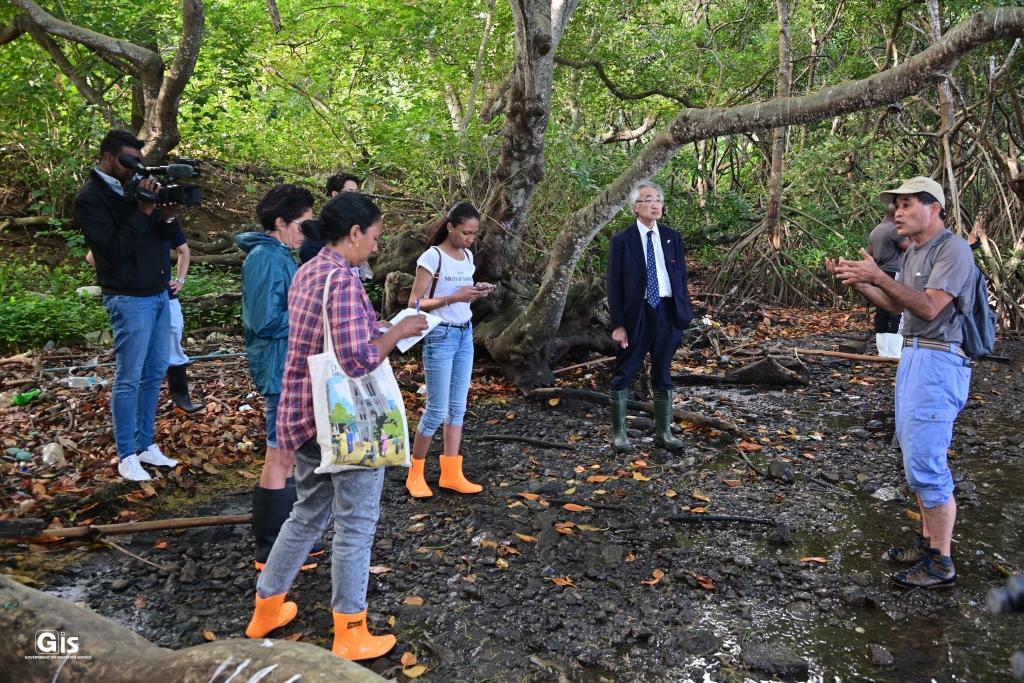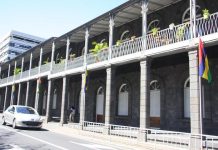
Africa-Press – Mauritius. A site visit was effected, on 14 October 2022, by a Japan International Cooperation Agency (JICA) delegation at the Blue Bay Marine Park Centre (BBMPC) with regard to the project for the “Development of Integrated Coastal Ecosystem Management System in the Republic of Mauritius” implemented following the oil spill of the MV Wakashio.
The Ambassador Extraordinary and Plenipotentiary of Japan to Mauritius, Mr Shuichiro Kawaguchi, as well as representatives from the Ministry of Blue Economy, Marine Resources, Fisheries and Shipping were present.
The project, which will be carried out in two phases, consists of the management of the marine ecosystem in the South East. The first phase, which started last May, will run until next August.
The second phase is scheduled for September 2023 and will last until August 2027. Coral reproduction, water quality sampling and mangrove forest monitoring are all part of this programme. Furthermore, an awareness and education space will also be created at the BBMPC. This project has several components.
These include: the establishment of a Coastal Ecosystem Management Committee which will bring together various partners; the monitoring of the coastal ecosystem; conservation and restoration of the ecosystem; as well as an awareness-raising campaign targeting the inhabitants of the south-east region, students and tourists.
An Action Plan, including coral restoration and reproduction, marine habitat protection, and a community-based ecotourism programme, will also be implemented.
Site Visit The site visit comprised a monitoring visit of corals in a glass-bottom boat. According to Ambassador Shuichiro Kawaguchi, JICA experts will work on the site to restore the corals.
The programme will also involve breeding, using a system set up by the Japanese. The technique used to restore the corals is unique and is a sustainable technology, he said.
“Reproduction is done using a Coral Settlement Device placed in the sea, which captures the coral larvae.
Once they have grown, the corals are transplanted elsewhere without damaging the mother coral. Until now, reproduction has been done directly on the mother corals,” he added.
The other focus of the programme is on awareness and education. The meeting room of the BBMPC will be transformed into an exhibition room. According to Ms Ayako Iizumi, who was part of the JICA delegation, the aim is to transform the BBMPC into an education hub dedicated to the environment.
Signs will be installed in the room to educate visitors about biodiversity, she added. She underlined that students in Grades 5 and 6 are particularly targeted.
“It will not be a simple visit, but active learning, with microscopes that they can use. They will go and collect sea water, which they can then observe and analyse,” she said.
As regards the health of mangroves and trees, the technical advisor from the JICA delegation, Mr Naohiro Matsui, recalled that the site comprises more than 20 hectares of forest.
“It is one of the largest concentrations of mangroves in Mauritius. The trees are between 80 cm and 1 metre tall.
It is a space rich in biodiversity that must be protected, especially in the face of climate change and rising sea levels,” he said. The same applies to other sites, such as Rivière-des-Créoles, which were severely impacted by the oil spill.
Mr Naohiro Matsui explained that three permanent sensors have been installed on the site to monitor water quality. The mass of the leaves is also measured with a special instrument.
“If the leaf mass decreases, it means that the plants are not healthy. If a mangrove leaf grows longer than it is wide, it means there is a problem,” he said.
The chlorophyll content of the leaves is also measured with a special instrument. The particularity of the mangroves of Rivière-des-Créoles is that they are large, at least ten metres high, making them the largest in Mauritius.
They are also the most productive, hence the interest for this site. There are two varieties of mangroves in Mauritius: the Rizophora Mucronata and the Bruguiera Gymnorrhiza.
The former has its roots in the air and uses them to breathe, while the latter sinks its roots underground and breathes through its leaves. It is to be recalled that Japan is continuing its efforts to help Mauritius after the Wakashio oil spill.
Shortly after the accident, a team of experts was dispatched for emergency operations and environmental impact assessments. JICA also sent experts to conduct a Data Collection Survey on the conservation and restoration of the coastal ecosystem during the period October to December 2020. At the request of the Mauritian government, JICA has started a new programme on integrated development and management of the coastal ecosystem.
For More News And Analysis About Mauritius Follow Africa-Press






